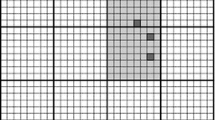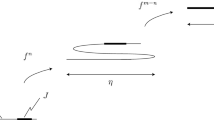Abstract
We consider one dimensional systems of particles interacting with each other through long range interactions that are translation invariant. We seek quasi-periodic equilibrium states.
Standard arguments show that if there are continuous families of quasi-periodic ground states, the system can have large scale motion, if the family of ground states is discontinuous, the system is pinned down. The transition between the two cases is called breakdown of analyticity and has been widely studied.
We use recently developed fast and efficient algorithms to compute all the continuous families of ground states even close to the boundary of analyticity. We show that the boundary of analyticity can be computed by monitoring some appropriate norm of the computed solutions.
We implemented these algorithms on several models. We found that there are regions where the boundary is smooth and the breakdown satisfies scaling relations. In other regions, the scalings seem to be interrupted and restart again. We present a renormalization group explanation of these phenomena. This suggest that the renormalization group may have some complicated global behavior.
Similar content being viewed by others
References
Greene, J.M.: A method for determining a stochastic transition. J. Math. Phys. 20(6), 1183 (1979)
Aubry, S., Le Daeron, P.Y.: The discrete Frenkel-Kontorova model and its extensions. I. Exact results for the ground-states. Physica D 8, 381 (1983)
Percival, I.C.: Variational principles for the invariant toroids of classical dynamics. J. Phys. A 7, 794 (1974)
Percival, I.C.: A variational principle for invariant tori of fixed frequency. J. Phys. A 12, L57 (1979)
MacKay, R.S.: Scaling exponents at the transition by breaking of analyticity for in commensurate structures. Physica D 50, 71 (1991)
Chandre, C., Jauslin, H.R.: Renormalization-group analysis for the transition to chaos in Hamiltonian systems. Phys. Rep. 365, 1 (2002)
Mather, J.: A criterion for the nonexistence of invariant circles. Inst. Hautes Études Sci. Publ. Math. 63, 153–204 (1986)
Frenkel, J., Kontorova, T.: On the theory of plastic deformation and twinning. Acad. Sci. USSR J. Phys. 1, 137 (1939)
Calleja, R., de la Llave, R.: A numerically accessible criterion for the breakdown of quasi-periodic solutions and its rigorous justification. Nonlinearity 23, 20292058 (2010)
Olvera, A., Simó, C.: An obstruction method for the destruction of invariant curves. Physica D 26, 181 (1987)
Wilson, K.G.: The renormalization group and critical phenomena. Rev. Mod. Phys. 55, 583 (1983)
de la Llave, R., Olvera, A.: The obstruction criterion for non-existence of invariant circles and renormalization. Nonlinearity 19, 1907 (2006)
Falcolini, C., de la Llave, R.: A rigorous partial justification of Greene’s criterion. J. Stat. Phys. 67, 609 (1992)
Lomelí, H.E., Calleja, R.: Heteroclinic bifurcations and chaotic transport in the two-harmonic standard map. Chaos 16(8), 023117 (2006)
Cardaliaguet, P., Da Lio, F., Forcadel, N., Monneau, R.: Dislocation dynamics: a nonlocal moving boundary. In: Free Boundary Problems. Internat. Ser. Numer. Math., vol. 154, pp. 125–135. Birkhäuser, Basel (2007)
Bates, P.W.: On some nonlocal evolution equations arising in materials science. In: Nonlinear Dynamics and Evolution Equations. Fields Inst. Commun., vol. 48, pp. 13–52. Am. Math. Soc., Providence (2006)
Rado, G.T., Shul, H. (eds.): Magnetism, vol. IIB. Academic Press, New York (1963)
Bügel, S., Bihimayer, G.: Magnetism of Low-dimensional Systems: Theory. Handbook of Magnetism and Advanced Magnetic Materials, vol. 1. Wiley, New York (2007)
Morse, H.M.: A fundamental class of geodesics on any closed surface of genus greater than one. Trans. Am. Math. Soc. 26, 25 (1924)
Candel, A., de la Llave, R.: On the Aubry-Mather theory in statistical mechanics. Commun. Math. Phys. 192, 649 (1998)
Mather, J.N.: Existence of quasiperiodic orbits for twist homeomorphisms of the annulus. Topology 21, 457 (1982)
de la Llave, R., Valdinoci, E.: Ground states and critical points for generalized Frenkel- Kontorova models in ℤd. Nonlinearity 20, 2409 (2007)
de la Llave, R.: KAM theory for equilibrium states in 1-D statistical mechanics models. Ann. Henri Poincaré 9, 835 (2008)
Calleja, R., de la Llave, R.: Fast numerical computation of quasi-periodic equilibrium states in 1D statistical mechanics, including twist maps. Nonlinearity 22, 1311 (2009)
de la Llave, R.: A tutorial on KAM theory. In: Smooth Ergodic Theory and Its Applications (Seattle, 1999), pp. 175–292. Am. Math. Soc., Providence (2001),
Salamon, D., Zehnder, E.: KAM theory in configuration space. Comment. Math. Helv. 64, 84 (1989)
Levi, M., Moser, J.: A Lagrangian proof of the invariant curve theorem for twist mappings. In: Smooth Ergodic Theory and Its Applications. Proc. Sympos. Pure Math., vol. 69 (Seattle, 1999), pp. 733–746. Am. Math. Soc., Providence (2001)
Jungreis, I.: A method for proving that monotone twist maps have no invariant circles. Ergod. Theory Dyn. Syst. 11, 79 (1991)
Stark, J.: An exhaustive criterion for the nonexistence of invariant circles for area-preserving twist maps. Commun. Math. Phys. 117, 177 (1988)
MacKay, R.S., Meiss, J.D., Stark, J.: Converse KAM theory for symplectic twist maps. Nonlinearity 2, 555 (1989)
Kadanoff, L.: Scaling laws for Ising models near tc. Physics 2, 263 (1966)
Amit, D.J.: Field Theory, the Renormalization Group, and Critical Phenomena. International Series in Pure and Applied Physics. McGraw-Hill International Book Co., New York (1978). ISBN 0-07-001575-9
Kadanoff, L.P.: Scaling for a critical Kolmogorov-Arnol’d-Moser trajectory. Phys. Rev. Lett. 47, 1641 (1981)
Shenker, S.J., Kadanoff, L.P.: Critical behavior of a KAM surface. I. Empirical results. J. Stat. Phys. 27, 631 (1982)
MacKay, R.S.: A renormalisation approach to invariant circles in area-preserving maps. Physica D 7, 283 (1983), order in chaos (Los Alamos, NM, 1982)
Koch, H.: A renormalization group for Hamiltonians, with applications to KAM tori. Ergod. Theory Dyn. Syst. 19, 475 (1999)
Abad, J.J., Koch, H., Wittwer, P.: A renormalization group for Hamiltonians: numerical results. Nonlinearity 11, 1185 (1998)
Koch, H.: A renormalization group fixed point associated with the breakup of golden invariant tori. Discrete Contin. Dyn. Syst. 11, 881 (2004)
Koch, H.: Existence of critical invariant tori. Ergod. Theory Dyn. Syst. 28, 1879 (2008)
Arioli, G., Koch, H.: The critical renormalization fixed point for commuting pairs of area-preserving maps. Commun. Math. Phys. 295, 415 (2010)
Dyson, F.J.: An Ising ferromagnet with discontinuous long-range order. Commun. Math. Phys. 21, 269 (1971)
Collet, P., Eckmann, J.-P.: A Renormalization Group Analysis of the Hierarchical Model in Statistical Mechanics. Lecture Notes in Physics, vol. 74. Springer, Berlin (1978)
de la Llave, R., Olvera, A., Petrov, N.P.: Universal scalings of universal scaling exponents. J. Phys. A 40, F427 (2007)
Author information
Authors and Affiliations
Corresponding author
Additional information
The work of R.C. has been supported by NSF grants and a FQRNT grant.
The work of R.L. has been supported by NSF DMS 0901389, and by Texas Coordinating board NHARP 0223.
Rights and permissions
About this article
Cite this article
Calleja, R., de la Llave, R. Computation of the Breakdown of Analyticity in Statistical Mechanics Models: Numerical Results and a Renormalization Group Explanation. J Stat Phys 141, 940–951 (2010). https://doi.org/10.1007/s10955-010-0085-7
Received:
Accepted:
Published:
Issue Date:
DOI: https://doi.org/10.1007/s10955-010-0085-7




